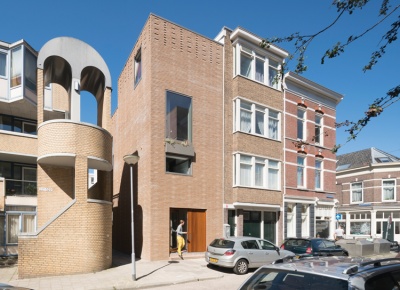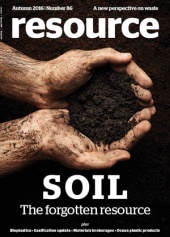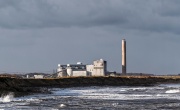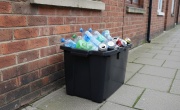WasteBasedBricks: Laying the foundations for sustainable building
A pioneering eco house in Rotterdam has been made using waste-based bricks that even the toughest of wolves couldn’t blow down. Leonie Butler learns more
When forward-thinking architects Nina Aalbers and her boyfriend Ferry in ‘t Veld decided to build their own house in the Dutch city of Rotterdam, two years ago, they were clear they wanted to make something with as small an ecological footprint as possible.
First off, they needed to find a plot of land on which to realise their dream. Though Rotterdam, with its mountains of high-rises, feels pretty dense, there are still empty plots in the city centre that lie between old houses and large-scale urban renewal projects. Rotterdam’s local government stimulates initiatives for such small-scale projects. After deciding on the neighbourhood they wanted, the pair found a small plot and contacted the local government with an email questioning, simply: “Can we build here?” The reply came back: “Yes, please!” This was in 2014.

When they started to design the 4.65 metre (m) wide, 8.8m deep, four-storey house, they wanted it to blend in with the surrounding area, meaning it should be built of bricks. But with an eye on sustainability, the question was: how should it be done? After extensive research, the couple found start-up company StoneCycling, based in Amsterdam, as in ‘t Veld explains: “From the moment we got in contact with StoneCycling, we saw this chance of designing a brick facade and being more sustainable by using WasteBasedBricks and knew this is what we wanted to achieve.”
The bricks themselves are made up of waste from the ceramics, glass and insulation industries, and rejected clay from traditional brick manufacturing – all sourced within a 100 kilometre radius – though the exact recipes are kept secret. The composition of different recipes can lead to unusual aesthetics and different coloured bricks, but they are still essentially bricks, as in ‘t Veld notes: “The stone does not look like waste. Actually, the small pieces in the brick that you can recognise as pieces of toilet bowls we used in a special brick bond pattern to make ornaments in the facade. In this way, we are showing the beauty of sustainability and the sustainability of beauty.”
All StoneCycling bricks are subjected to market tests to ensure they are safe to use according to European standards. They are checked, for example, for frost resistance and the maximum pressure the brick can take. Despite this, the industry is typically risk averse and profit driven, and StoneCycling co-founder Ward Massa is particularly pleased that the architect duo took a gamble on the company: “In general, [architects] love the products because it opens up a whole new range of possibilities in terms of colours and textures. On the other hand, they want to see proof. Realising a number of projects is extremely important to take away any scepticism about building from waste.
“It’s quite amazing that [Aalbers and in ‘t Veld] decided to invest more money and time and take an extra risk to be the first to live in a waste-based house”, he says. “But it is inspiring to see a new generation that believes in a different way of designing, living, building, maintaining and demolishing.”

in ‘t Veld says that a visit to the factory and a meeting with Massa and his co-founder Tom van Soest convinced them that the WasteBasedBricks were the way forward: “We found out all the possibilities of the brick and shared our ideas of what we think a brick should look like. We ended up with a brick with more of a rough surface than the original StoneCycling brick... We then designed a bond pattern to incorporate the sliced version to show the grain of the ingredients of the brick.”
Indeed, the architects seem more than happy to try something new: “It is very exciting and challenging to work with a new product which hasn’t been applied yet, since you can never be sure how it will work out on the building site and how it will look in a few years.
“Working together as two young companies brings in a lot of positive energy. And the stone is of great quality: when the mason was building a test wall, he was truly impressed by the quality of the brick. He showed us by breaking the brick with his trowel in two. Apparently a lot of bricks nowadays break [into a] thousand pieces.”
However, getting uncontaminated waste streams from demolition is a challenge. One idea is to introduce a building material passport (a document describing the materials used in a building), which would make it easier at the end of a building’s life to identify materials for reuse. With guaranteed provenance of the building materials, there would then be a way of selling it on and thereby incentivising strategic demolition.
 This article was taken from Issue 86
This article was taken from Issue 86Currently, the bricks are three times as expensive as standard bricks. But, you could argue, as the company does, that because they come in all sorts of colours with mouth-watering names like Blueberry, Nougat, Truffle and Wasabi (the Rotterdam house uses Caramel ones), and can be made in any size you want, it is not a standard brick. However, like anything, it is hoped that the more they are used, the cheaper they will become.
The result of Aalbers and in ‘t Veld’s project is an attractive building they live and work in, comprising of: the ground floor kitchen and eating room; the first-floor office and bathroom; the second-floor living room; a top-floor sleeping room; and a rooftop terrace. StoneCycling estimates that around 15,000 kilos of waste has been upcycled into the new building.
Having moved into the new house just in August, the couple is still overwhelmed with what they have achieved. “We get a lot of nice comments on the house. People take a detour to see the house and when they see us, we get the thumbs up”, in ‘t Veld says proudly. “The local government is happy with the house, it will feature as part of a tour they organised around sustainable homes. Neighbours say it suits the street well and it upgraded the site – we feel very welcome by those comments. We would definitely use the bricks again in a design, when they suit the project.”
He concludes: “As an architect, I think we should be more aware of the possibilities to innovate within traditions. For more and more products, the source should be waste!” 





